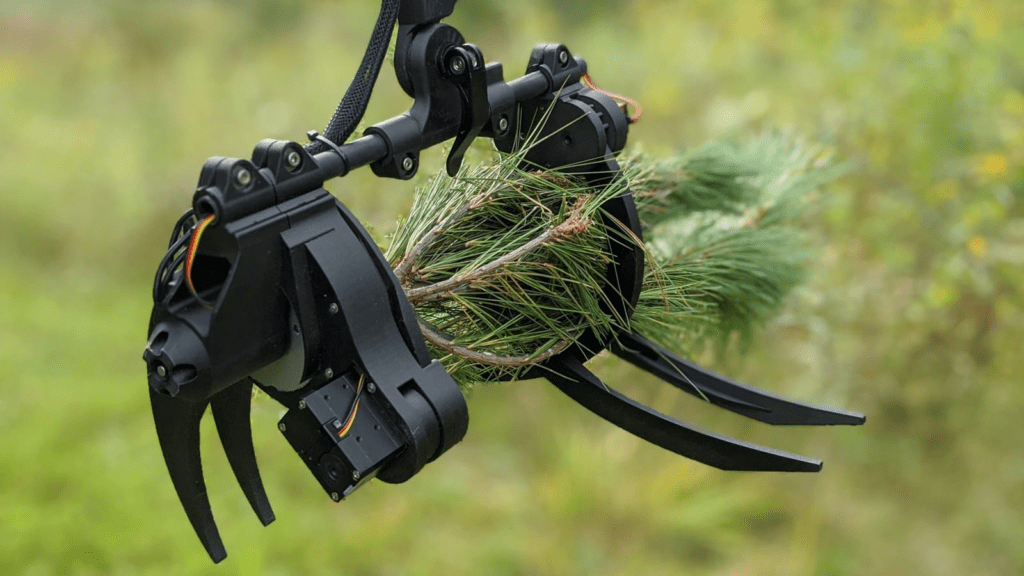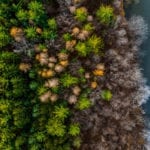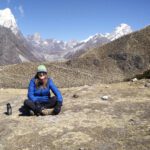What do a crane, a climbing rope, and a pruning pole have in common? They are all tools used in forest research. Scientists use them to cut branches down from tree canopies to then study in the lab.
These methods are often expensive, dangerous, and impractical. Alternatives are needed.
Introducing DeLeaves: a new vegetation-sampling tool that attaches to a drone and is flown to treetops by an operator on the ground.
Studying leaves from tree canopies can tell us how climate change affects forests, how fertilization impacts tree plantations, how biodiversity is changing, and more.
Two newly published and open access studies in the Canadian Journal of Forest Research and the Journal of Unmanned Vehicle Systems describe DeLeaves and how this novel technology can transform forest science.
“The tool includes a rotating saw, a branch-holding mechanism, a small camera, and control electronics,” explains Dr. Alexis Lussier Desbiens, Professor of Mechanical and Robotic Engineering at the Université de Sherbrooke, and co-author on both papers.
“You suspend it under an off-the-shelf drone and fly it to a specific GPS coordinate. The tool can fly hundreds of meters into the forest and go above the trees, locate a branch, and lower down. Then you push a button to capture the branch, cut it, hold it in place, and bring it back. It can take as little as one minute, and you can watch the whole process on a screen on the ground.”

DeLeaves sampling tool | © DeLeaves, used with permission
Desbiens and the DeLeaves team initially developed the tool for researchers at the UBC Botanical Garden, who wanted something to take on an expedition to Vietnam.
The team thought the tool would be useful for botanical gardens but have few other applications. The more they talked to scientists though, the more they realized this was a dream tool for forest researchers.
“We started to understand that your ability to access the canopy dictates your research. You build your research protocols around the tools you have,” says Desbiens.

Branch cutting mechanism | © DeLeaves, used with permission
For ecologists like Université de Montréal (UdeM) postdoc Dr. Anna K. Schweiger, the tools used to study ecosystem functions and services include: a pruning pole, laboratory tests to measure chemicals in leaves, and airborne imaging spectrometers—“basically, cameras mounted on airplanes [that can] measure how much light is reflected from leaves,” explains Schweiger.
Pruned leaves are analyzed in the lab and the biochemical information is matched to reflectance values of leaves measured by spectrometry in the field. Models are then built that predict leaf chemistry from spectral measurements alone, and the model outputs are used to map functional traits of plants so that we can better see how forests are changing.
In 2019, Schweiger and Dr. Etienne Laliberté, Associate Professor at UdeM, added DeLeaves to their toolbox.

Sampling leaves with a pole pruner | Schweiger et al.
The team sampled sugar maple trees and measured chemical and structural traits of the leaves. They used a traditional pruning pole to get branches from the edges of the canopy—which was as high as the pruner could go—and the DeLeaves tool to cut branches down from the very top of the canopy.
“Because we were dealing with sun leaves [leaves that receive direct sunlight and are not blocked by any other leaves], we assumed that the two samples would be comparable, but they were not,” says Schweiger. “We saw significant differences in all traits.”
This means that since airplane spectrometers measure the tops of canopies, researchers on the ground should be sampling those same leaves. Otherwise models are not accurate.
“Matching what a spectrometer sees is crucial and it matters if you are one meter off,” adds Schweiger. “We are seeing that with DeLeaves we can capture more accurate information which helps correctly map functional traits, tree species, and forest health.”
DeLeaves can be purchased from a start-up company founded by Université de Sherbrooke engineers Guillaume Charron and Hughes La Vigne. If you are comfortable operating DJI’s industrial drones, like the M200 or the M600, you should be able to operate DeLeaves. Researchers can also hire drone operators through the company.
The DeLeaves team is excited for people to use the tool and let them know how it’s going. Desbiens points out that there should be more back and forth feedback and open communications between scientists and engineers.
“There are a lot of bright young engineers who want to help with conservation and are great at building technologies. We want to help improve how science is done by building innovative devices. If you have different tools you will think differently and that’s what’s exciting about this project.”
Read the open access papers: Foliar sampling with an unmanned aerial system (UAS) reveals spectral and functional trait differences within tree crowns in the Canadian Journal of Forest Research and The DeLeaves: a UAV device for efficient tree canopy sampling in the Journal of Unmanned Vehicle Systems.
Header image: © DeLeaves, used with permission.




